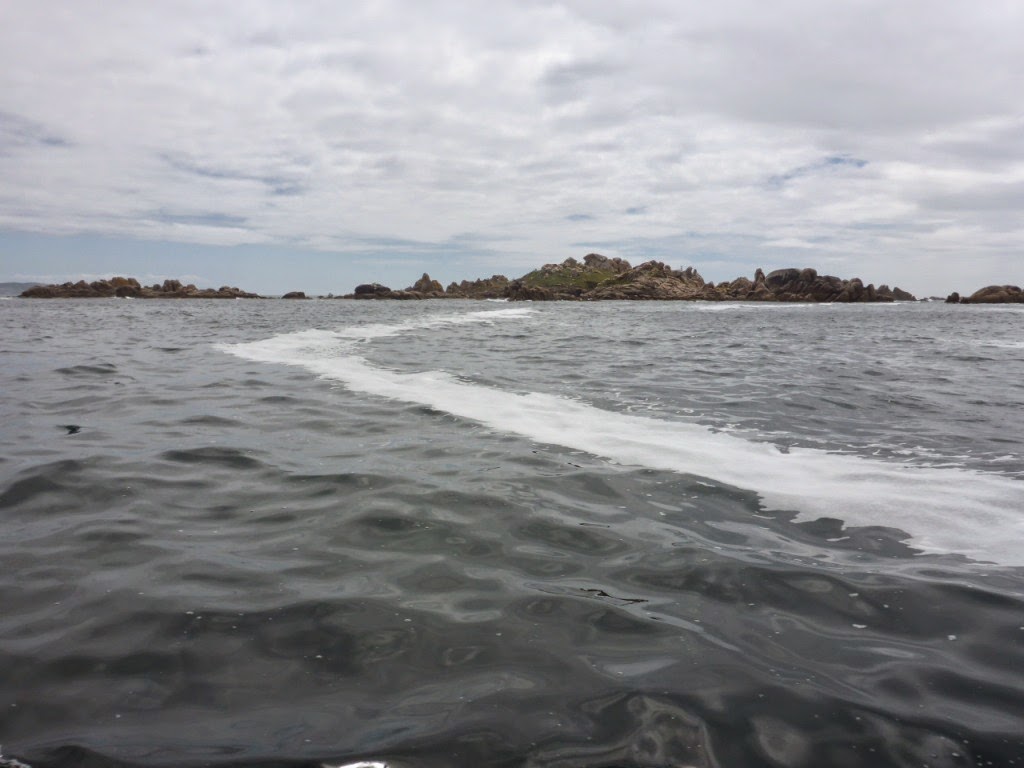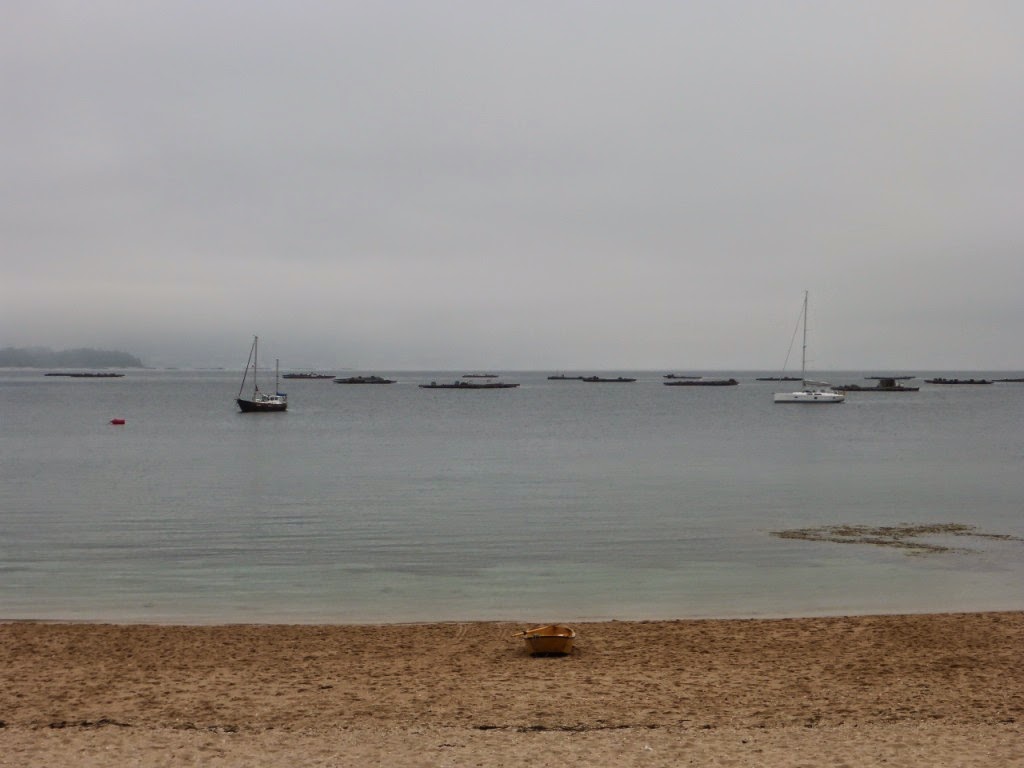Je vais à la poste poster deux cartes postales, une pour Estrid (une vieille tante de Jens au Danemark) et l’autre pour mon frère Michel. Puis nous partons à 10 h par temps très calme et un peu brumeux. On ne voit pas le phare de cap Finisterre en passant, il est caché dans la brume. Jens met le pilote automatique … et il ne marche pas! Il se replonge dans la cale , titille un peu les contacts et il se met à marcher. Nous longeons la côte vers le sud, mais ne voyons pas grand chose à terre à cause de la brume. Nous allons au moteur, il n’y a pratiquement pas de vent et le peu qu’il y a est de face. Nous rentrons dans la ría de Arousa, une très grande ría, 30 km de long et 15 km de large. C’est presque comme une mer intérieure. L’entrée est étroite et il faut passer au bon endroit. Les côtes à l’intérieur sont construites, villages succédant à d'autres villages et la circulation de bateaux variés, pêche et plaisance, assez intense. Mais ce qui attire l’œil tout de suite, ce sont les parcs à moules. On en voit des centaines. Nous allons profiter du temps calme pour ancrer. Le guide indique une baie avec un bon ancrage près de “Illa de Arousa” (Ile d’Arousa). Nous y allons, plusieurs voiliers y sont déjà ancrés. C’est en face d’une jolie plage, “sauvage”, je veux dire sans maisons. Je suis au volant, arrive doucement et Jens laisse tomber l’ancre. Nous attendons un peu et je mets le moteur en marche arrière pour tester si on tient. Et nous reculons! L’ancre ne tient pas. Donc, on la remonte et on recommence. Et là elle tient. Nous n’avons pas beaucoup d’expérience d’ancrage, nous ne l’avons fait qu’une fois en Ecosse en juillet 2012 et je n’en garde pas un bon souvenir: il soufflait un vent fort, la chaine grinçait et je n’avais pas dormi. Nous prenons donc un ankerdram bien mérité (jus d’orange, on est raisonnable) et nous baignons, directement du bateau. Un voilier suisse arrive, ancre, recule et recommence, comme nous. Les autres voiliers partent en fin de journée, ce sont des Espagnols qui sont venus passer la journée à la plage en bateau. Nous restons trois voiliers à passer la nuit ici, un Suisse, un Espagnol et nous. Nous dinons sur le bateau et allons avec l’annexe boire un café à la plage. Il est 22 h et il y a encore pleins de monde.
Si on regarde la plage du bateau, c’est idyllique mais derrière, les parques à moules ne sont pas très beaux. Et il fait gris, ce serait plus gai sous le soleil.
Wednesday, August 6, 2014
I go to the post office to send two postcards, one for Estrid (an old aunt of Jens in Denmark) and one for my brother Michel. Then we leave at10 am, by a quiet weather and a little foggy. We don’t see the lighthouse of Cape Finisterre in passing, it is hidden in the mist. Jens puts on the autopilot ... and it doesn’t work! He plunges into the hold gain, tickles a little the contacts and it starts working. We navigate along the coast to the south, but don’t see much to land because of the fog. We're going with the engine, there is virtually no wind and the little there is is against us. We enter the Ria de Arousa, a large ría, 30 km long and 15 km wide. It's almost like an inland sea. The entrance is narrow and you have to go to the right place. The coasts, inside, are much built, towns and villages succeeding each other, and the traffic of various boats, fishing boats and sailing boats is pretty intense. But what catches the eye immediately, is the mussels parks. We see hundreds of them. We'll enjoy the quiet time today to anchor. The guide shows a bay with a good anchorage on the “Illa de Arousa” (Arousa island). Several sailboats are already at anchor. It is opposite a beautiful beach, "wild", I mean without houses. I'm at the wheel, motoring slowly and Jens drops the anchor. We wait a bit and I put the motor in reverse to test if it holds. And we go back! The anchor doesn’t hold. So Jens pulls it up and drops it again. And this time, it holds. We do not have much experience of anchoring, we did that once in Scotland in July 2012 and I don’t have good memories of it: it was blowing a strong wind, the chain squeaked and I didn’t sleep. We take a well deserved ankerdram (orange juice, we are reasonable) and we swim directly from the boat. A Swiss boat arrives, anchors and the anchor doesn’t hold, like we did. The other boats depart in the late afternoon, they were the Spaniards who came to spend the day at the beach by boat. We are three boats which spend the night here, a Swiss, a Spaniard and us. We have dinner on the boat and go with the tender to have coffee at the beach. It is 10 pm and there are still many people.
If you look at the beach from the boat it is idyllic but behind Maja the mussel parks are not very beautiful, and the gray weather doesn’t help, it would be prettier under the sun.
Bye, bye Finisterre
On ne voit pas le phare au Cap Finisterre
We don't see the Finisterre light house
Jens titille le moteur du pilote automatique
Jens tickles the contacts in the autopilot
Calme
Quiet
Jens cherche un bon ancrage dans le guide
Jens is looking for a good anchorage in the guide
De la mousse à l'entrée de la ría d'Arousa
Foam at the Arousa ría entrance
Phare, ría Arousa
Light house, Arousa ría
Maisons, bateaux
Houses, boats
Parc à moules
Mussels park
La plage où nous ancrons
The beach where we anchor
Je nage du bateau
I am swimming from the boat
Jens nage du bateau
Jens is swimming from the boat
Un truc pour éviter que la chaine grince
A tricks to prevent the chain squeaking
Nous sommes trois à l'ancre
We are three boats anchored
Maja
Un café à la plage
A café at the beach
Un bateau de pêche. Arousa
A fishing boat. Arousa
Une très jolie fleur sauvage. Arousa. Amaryllis?
A very pretty wild flower. Arousa. Amaryllis?

















